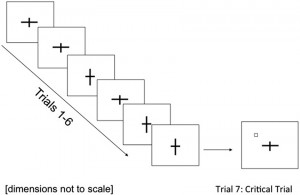It is a natural assumption we all make, that when our eyes are open, we are ‘seeing’ everything in our visual field. However this is not often the case.
Before you continue reading, watch the following video and count how many times the players dressed in white pass the ball to each other.
The correct answer is that they pass the ball to each other 15 times, but the real question is, did you see the gorilla? If the answer is no… go back and watch the video again but this time without focusing on the number of passes the players make. But don’t worry if you didn’t spot him the first time! This video is based an experiment performed by Daniel Simons and Christopher Chabris in 1999 and they found that amazingly 50% of their participants failed to notice the gorilla. So what is it that causes us to miss such a supposedly obvious feature of the video?
Selective Attention
Attention is the process by which people select certain information from their surrounding environment, and focus in on only that, thereby discarding the rest of the sensory input. This is because we have a limited cognitive capacity, and so have to filter out what we assume to be irrelevant, or else we would be subject to a sensory over load. This is as Broadbent (1958) described it, like the brains way of filtering incoming information. This means that at any given time we are only attending to a select area of our visual field, and often miss large changes in the areas of the environment we are not focusing on. (You now have an excuse when you don’t realise you friend got a new hair cut..!).
Inattentional Blindness
Inattentional blindness is an extension of selective attention, and it claims that without attention no features from our surroundings are perceived at all. Mack and Rock (1998) were among the first psychologists to study this phenomenon, and they argued that it occurred when the participants in their experiments were attending to a specific stimulus, and so were unaware of others presented to them. This suggests that missing an external stimulus in your visual field is no reflection on a deficit in your perceptual abilities, but in your ability to attain. Therefore we concentrate mostly on what we find important, and then simply allow our schemas to fill in the rest.
How can we test this phenomenon?
Mack and Rock would show their participants a series of crosses, aligned either horizontally or vertically, and they were asked to determine which arm of the cross was longer. On the critical trial, the cross shows up like all the previous trials, but it is accompanied by a small shape. Afterwards the subjects were asked if they noticed any shapes other than the cross, and the results showed that 75% of the participants were inattentionally blind when the cross was given parafoveally, and the unexpected shape appeared at the fixation point. In addition to this, they also allowed for an assessment of perception under divided attention, by repeating the experiment, but suggesting to the participants that something other than the cross might appear. This showed that when the subjects were aware that something would change (they attended more to the external environment), they were far more likely to notice the additional shape.
An explanation for Inattentional Blindness
A salient object is one that stands out from the rest, and so because our brain doesn’t have the cognitive capacity to process and retain every stimulus from our environment, we rely on our schemes to fill in the rest, and focus only on those which are salient. A schema in this sense is effectively a mental arrangement of preconceived ideas that develops throughout ones life. This is a very economical approach to perception, as attending to, and cognitively processing only the important aspects of our environment doesn’t over load our cognitive capacity, but does allows us to create a fairly cohesive idea about the world around us.
But why do we miss such as obv ious environmental stimulus, that is the presence of a man dressed as a gorilla?! This answer to this could be due to the fact that it is such an unexpected event, that it completely lacks ecological validity. Therefore because we aren’t expecting it, we are less likely to notice it, as we are attending only to the most salient stimuli.
ious environmental stimulus, that is the presence of a man dressed as a gorilla?! This answer to this could be due to the fact that it is such an unexpected event, that it completely lacks ecological validity. Therefore because we aren’t expecting it, we are less likely to notice it, as we are attending only to the most salient stimuli.
Whodunnit?!
The following video is taken from a British TV advert, promoting increased attention when driving, and nicely demonstrates our inability to notice changes in our visual field that we are not attending to.


